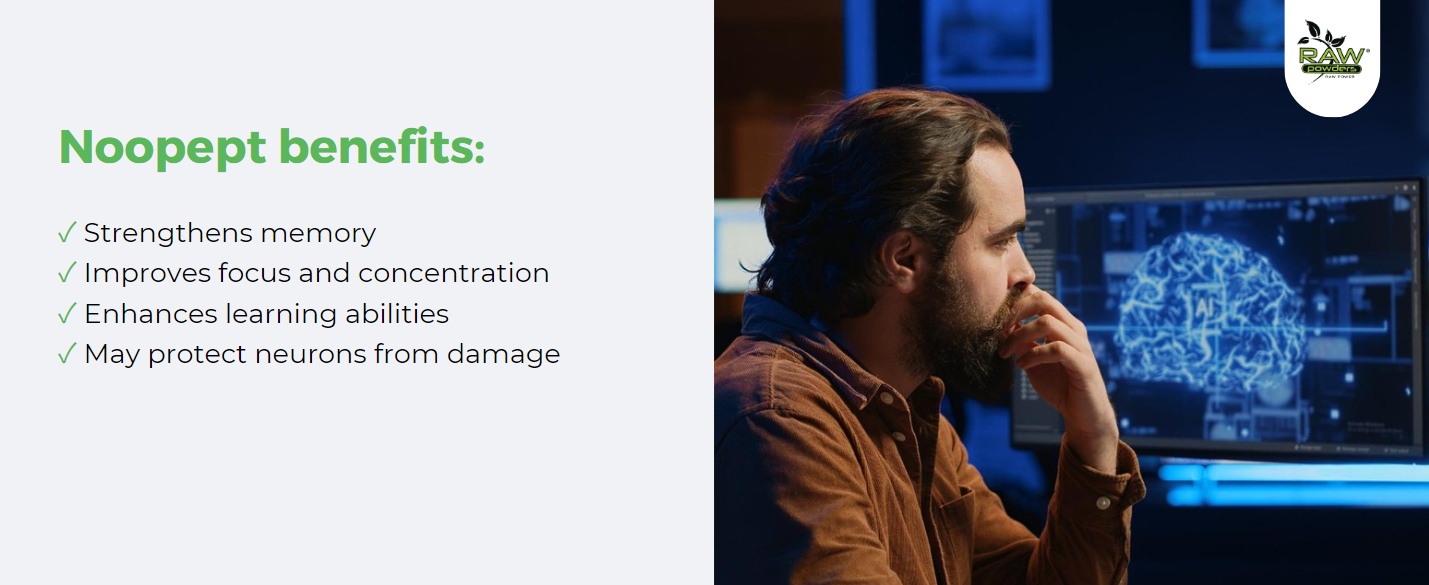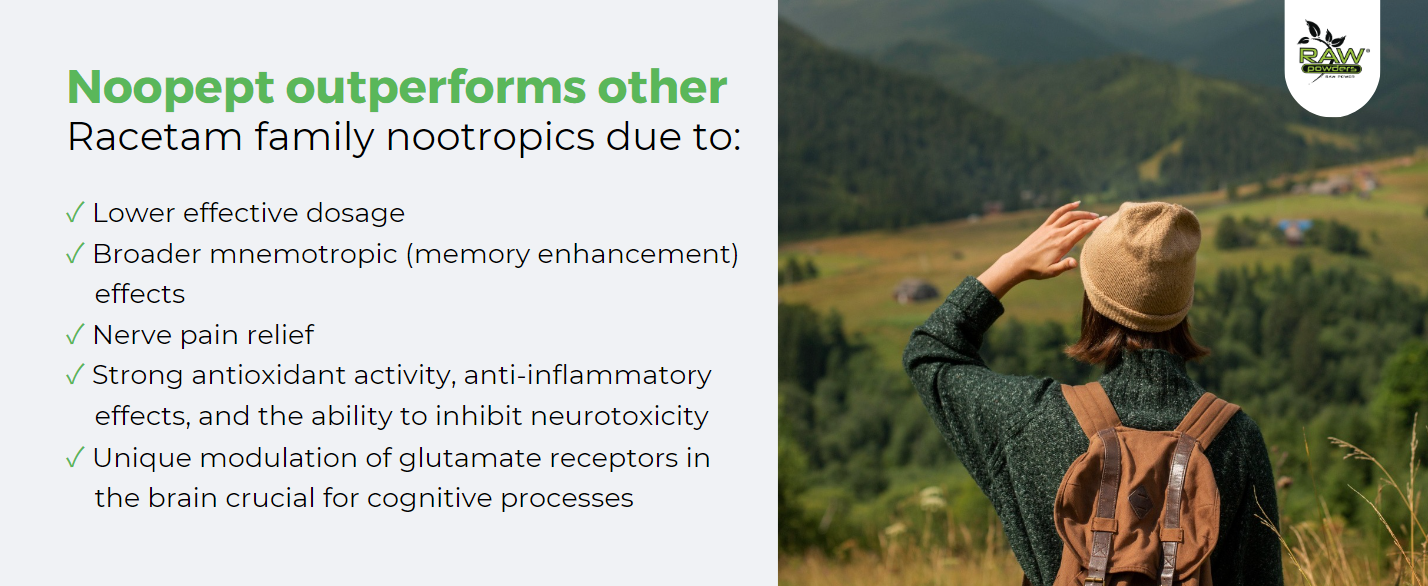NOOPEPT BENEFITS AND EFFECTS


Noopept, recognized as a highly effective nootropic, has gained popularity in the field of cognitive enhancement. This synthetically formulated supplement, which shares similarities with Piracetam, is noted for its significant impact on cognitive function, even at lower doses. Its growing appeal among nootropics enthusiasts calls for an in-depth exploration of its diverse benefits.

Overview of Benefits
Memory Enhancement
Noopept is primarily lauded for its ability to enhance memory. Scientific studies have shown that it can restore spatial memory and improve long-term memory in various models of cognitive impairment, including Alzheimer's disease. For instance, Noopept was effective in restoring spatial memory in mice models of Alzheimer's disease and mitigating memory deficits induced by β-amyloid(25–35) in rats [1, 2].
Learning Ability
Noopept also facilitates increased learning ability. It has been shown to normalize learning capacity in animals with ischemic damage to the cerebral cortex and improve learning in various animal models, indicating its potential to enhance cognitive processing and information absorption [3].
Focus and Concentration
Beyond enhancing memory and learning, Noopept is known for possibly improving focus and concentration. It has been observed to increase the frequency of inhibitory synaptic transmission in hippocampal neurons, which could contribute to enhanced cognitive functions, including attention and focus [4].
Neuroprotective Properties
One of the most significant aspects of Noopept is its neuroprotective properties. Studies have shown that Noopept can protect neurons from damage caused by conditions like Alzheimer's disease. It does so by inhibiting oxidative damage, reducing apoptosis, and attenuating tau hyperphosphorylation, all of which are critical in protecting neuronal health and function [5]. Additionally, Noopept stimulates the expression of nerve growth factors like NGF and BDNF in the hippocampus, which are vital for cognitive health and brain function [6].
In conclusion, preliminary studies assume that Noopept offers a comprehensive range of cognitive enhancements, from memory and learning improvement to increased focus and significant neuroprotection, making it a valuable supplement for cognitive health and enhancement.

Comparative Analysis of Noopept and Racetam Family Nootropics
Comparative Pharmacological Properties
Noopept, compared to other nootropics in the Racetam family, is distinguished by its significantly lower effective dose and a broader spectrum of mnemotropic (memory-enhancing) activity. Notably, according to one study, while Piracetam mainly facilitates the early stages of memory processes, Noopept positively influences memory consolidation and retrieval. Additionally, Noopept has an anxiolytic action, which is not typically observed with Piracetam [7].
Effects on Acetylcholine-Induced Current
Studies have shown that Noopept and Piracetam alter the amplitudes of acetylcholine-induced influx currents in neurons, with Noopept exhibiting a bell-shaped dose curve and Piracetam showing a monotonous rise at physiological concentrations. This suggests differences in their mechanisms of action at the neurotransmitter level [8].

Neuroprotective Properties
Noopept exceeds Piracetam in terms of its neuroprotective effects. It demonstrates potent antioxidant activity, anti-inflammatory action, and the ability to inhibit neurotoxicity from excess calcium and glutamate. This multifaceted neuroprotective action contributes to its effectiveness in various forms of brain ischemia and other neuronal models, which is a significant advantage over Piracetam. This effect, in combination with its previously found nootropic and neuroprotective properties, makes this systemically active dipeptide a promising clinical drug for the treatment of stroke and other disorders associated with a deficiency of the endogenous antioxidant system. [9].
Influence on Glutamate Receptors
Noopept exhibits a distinct influence on glutamate receptors in the brain compared to other nootropics. While some drugs in the Racetam family do not significantly affect glutamate receptors, Noopept shows a more specific action, indicating a selective modulation of these receptors which are crucial for cognitive processes [10].
Behavioral and EEG Effects
Noopept and Piracetam display similarities in EEG effects and their mediatory mechanisms. For instance, both drugs initially enhance alpha and beta EEG activity, but this effect diminishes with repeated administration, reflecting a potential difference in their long-term impact on brain activity [11].
Conclusion
Noopept offers a range of benefits for those looking to enhance their cognitive functions. Its potential in memory improvement, learning ability, focus, and neuroprotection makes it a compelling choice in the field of nootropics. As with any supplement, it's essential to approach Noopept use with an understanding of its effects, backed by both scientific research and careful personal consideration.
For more information on Noopept supplement use, dosage, and potential side effects, visit the blog: Noopept dosage, Noopept side effects.
Medical Disclaimer
The information provided in our articles is solely for educational purposes and should not be considered medical advice or instruction. No action or inaction should be taken based solely on the contents of this information. Readers should consult their health care professional on any matter related to their health and well-being. The information and opinions provided here are believed to be accurate and sound, based on the best judgment available to the authors, but readers who fail to consult with appropriate health authorities assume the risk of any injuries. The publisher is not responsible for errors or omissions.
Please be aware that different countries may have specific regulations and that this disclaimer does not replace the need for consultation with a healthcare provider before beginning or changing a treatment or supplement regimen. The information contained in this article is not intended to diagnose, treat, cure, or prevent any disease. Individual results may vary.
References
- Ostrovskaya, R., Gruden, M., Bobkova, N., Sewell, R., Gudasheva, T., Samokhin, A., Seredinin, S., Noppe, W., Sherstnev, V., & Morozova-Roche, L. (2007). The nootropic and neuroprotective proline-containing dipeptide noopept restores spatial memory and increases immunoreactivity to amyloid in an Alzheimer's disease model. Journal of Psychopharmacology, 21, 611 - 619. https://doi.org/10.1177/0269881106071335.
- Ostrovskaya, R., Belnik, A., & Storozheva, Z. (2008). Noopept efficiency in experimental Alzheimer disease (cognitive deficiency caused by β-amyloid25–35 injection into Meynert basal nuclei of rats). Bulletin of Experimental Biology and Medicine, 146, 77-80. https://doi.org/10.1007/s10517-008-0211-6.
- Romanova, G., Shakova, F., Gudasheva, T., & Ostrovskaya, R. (2002). Impairment of Learning and Memory after Photothrombosis of the Prefrontal Cortex in Rat Brain: Effects of Noopept. Bulletin of Experimental Biology and Medicine, 134, 528-530. https://doi.org/10.1023/A:1022940507519.
- Kondratenko, R., Derevyagin, V., & Skrebitsky, V. (2010). Novel nootropic dipeptide Noopept increases inhibitory synaptic transmission in CA1 pyramidal cells. Neuroscience Letters, 476, 70-73. https://doi.org/10.1016/j.neulet.2010.04.005.
- Ostrovskaya, R., Vakhitova, Y., Kuzmina, U., Salimgareeva, M., Zainullina, L., Gudasheva, T., Vakhitov, V., & Seredenin, S. (2014). Neuroprotective effect of novel cognitive enhancer noopept on AD-related cellular model involves the attenuation of apoptosis and tau hyperphosphorylation. Journal of Biomedical Science, 21. https://doi.org/10.1186/s12929-014-0074-2.
- Ostrovskaya, R., Gudasheva, T., Zaplina, A., Vahitova, J., Salimgareeva, M., Jamidanov, R., & Seredenin, S. (2008). Noopept stimulates the expression of NGF and BDNF in rat hippocampus. Bulletin of Experimental Biology and Medicine, 146, 334-337. https://doi.org/10.1007/s10517-008-0297-x.
- Ostrovskaia, R., Gudasheva, T., Voronina, T., & Seredenin, S. (2002). [The original novel nootropic and neuroprotective agent noopept].. Eksperimental'naia i klinicheskaia farmakologiia, 65 5, 66-72 . https://pubmed.ncbi.nlm.nih.gov/12596521/
- Razumovskaya, M., Murzina, G., Ostrovskaya, R., & Pivovarov, A. (2019). Modulation of Nicotinic Receptors in Neurons in the Common Snail by Noopept and Piracetam. Neuroscience and Behavioral Physiology, 49, 1127 - 1134. https://doi.org/10.1007/s11055-019-00849-2.
- Fedorova, T., Us, K., & Ostrovskaya, R. (2007). Estimation of the antioxidant effect of the nootropic dipeptide Noopept on the model of Fe2+-induced chemiluminescence of lipoproteins of human serum in vitro. Neurochemical Journal, 1, 260-263. https://doi.org/10.1134/S1819712407030154.
- Firstova, E V Vasil'eva, G I Kovalev. [Studying specific effects of nootropic drugs on glutamate receptors in the rat brain]. Eksp Klin Farmakol. 2011;74(1):6-10. PMID: 21476267. https://pubmed.ncbi.nlm.nih.gov/21476267/
- Vorobyov, V., Kaptsov, V., Kovalev, G., & Sengpiel, F. (2011). Effects of nootropics on the EEG in conscious rats and their modification by glutamatergic inhibitors. Brain Research Bulletin, 85, 123-132. https://doi.org/10.1016/j.brainresbull.2011.02.011.




_front%20(1)-250x250.png)


_front%20(1)-250x250.png)

-(NN)_front%20(1)-min-250x250.png)

_front%20(1)-250x250.png)


_front%20(1)-min-250x250.png)
_front%20(1)%20(1)-250x250.png)




_front%20(1)-min-250x250.png)


_front-250x250.png)
_front-250x250.png)
